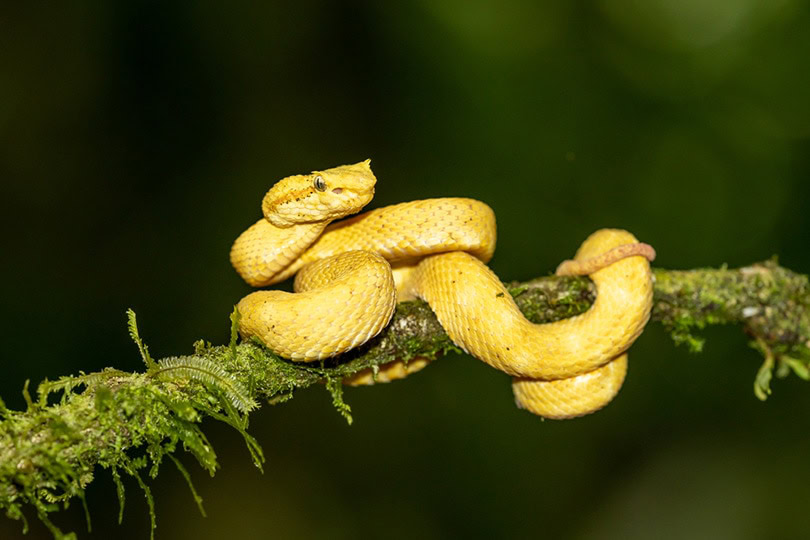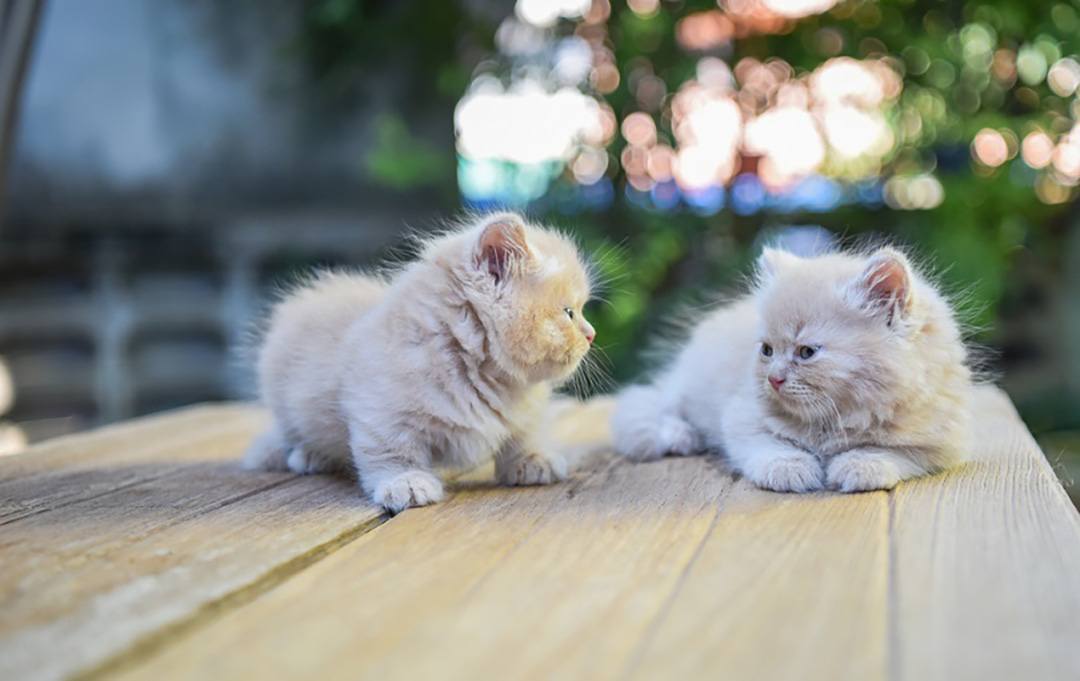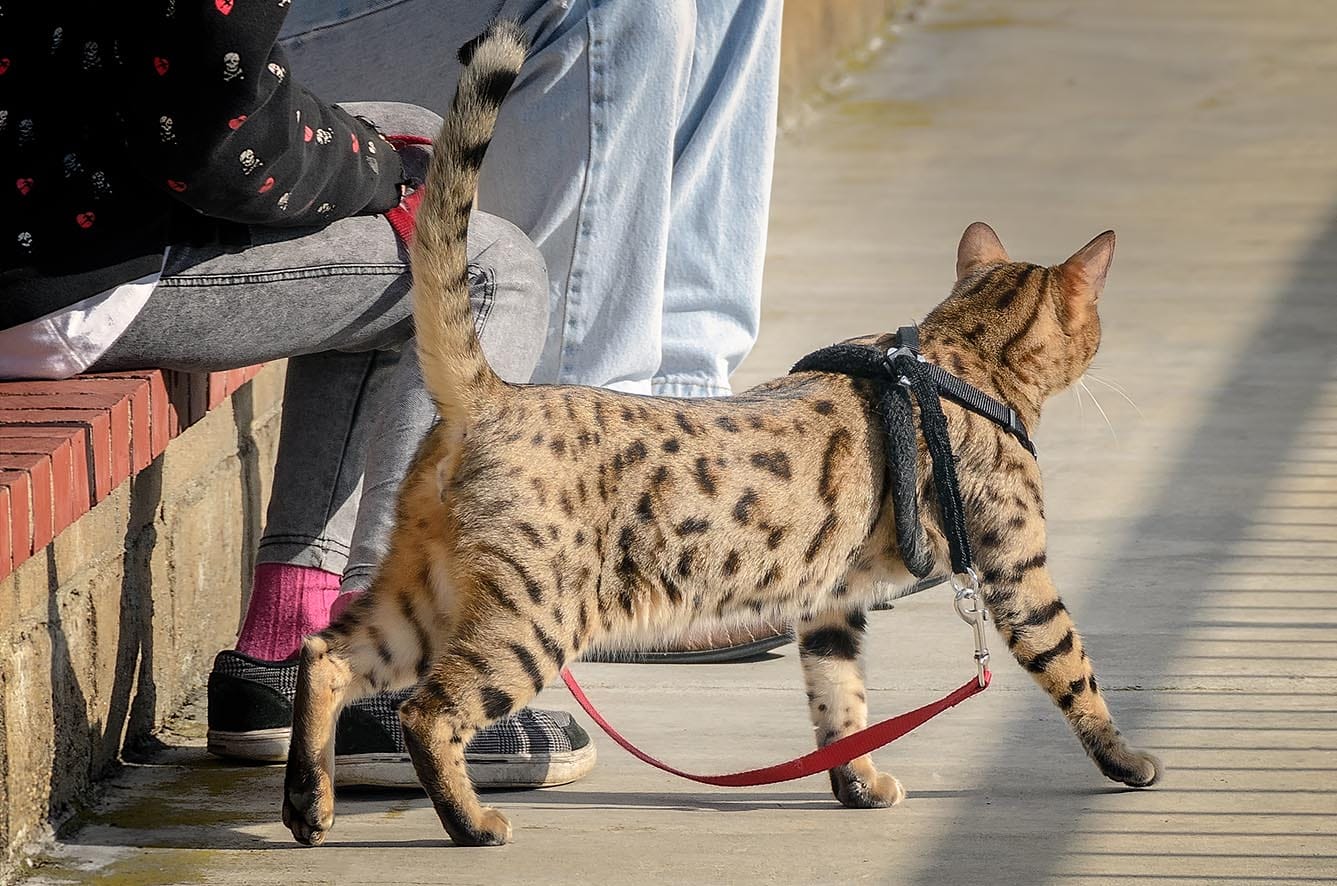With over 3,700 species of snakes in diverse environments all over the world, it comes as no surprise that they come in stunningly beautiful colors and patterns. Some snakes develop vibrant colors to blend in with the rainforest or forest floor, while others have bright colors and patterns to warn predators. In captivity, breeders harness the power of genetics to create unique and rare color variations to entice private collectors.
Whether you love or fear them, keep reading for the 13 most beautiful snakes in the world and marvel at the wonders of diversity in reptiles.

The 13 Most Beautiful Snakes in the World
1. Boelen’s Python
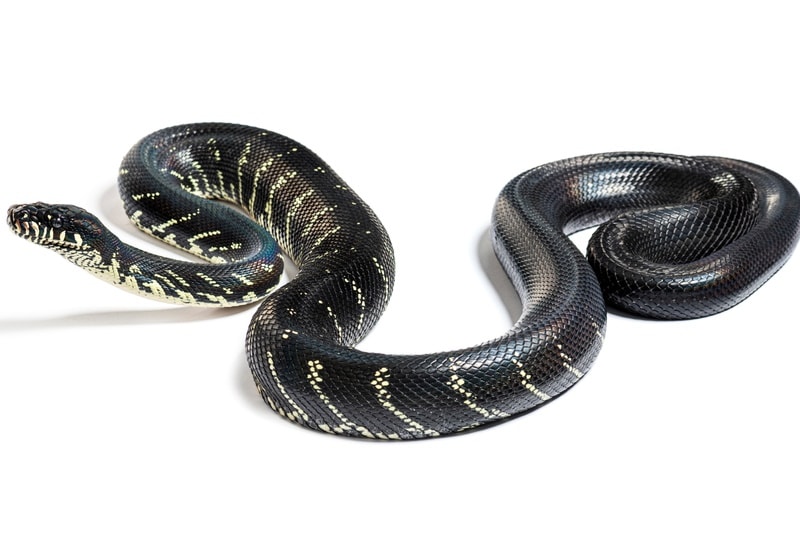
| Scientific Name: | Simalia boeleni |
| Habitat: | Forested montane regions |
| Size: | Up to 9.8 feet |
The Boelen’s python, also known as the Boeleni python, is a rare and gorgeous non-venomous python native to the mountains of New Guinea. The snake is black with hints of purple or blue and a white or pale-yellow underside that extends up the sides of the body. The mouth is patterned with similar pale or white labial scales. What makes this snake so striking, however, is the iridescent sheen of its scales that resembles an oil slick.
Boelen’s pythons are a coveted species for private collectors, leading to many wild-caught species in the pet trade. They are also difficult to breed in captivity, furthering their scarcity. These factors make the Boelen’s python one of the most expensive snakes.
2. Emerald Tree Boa
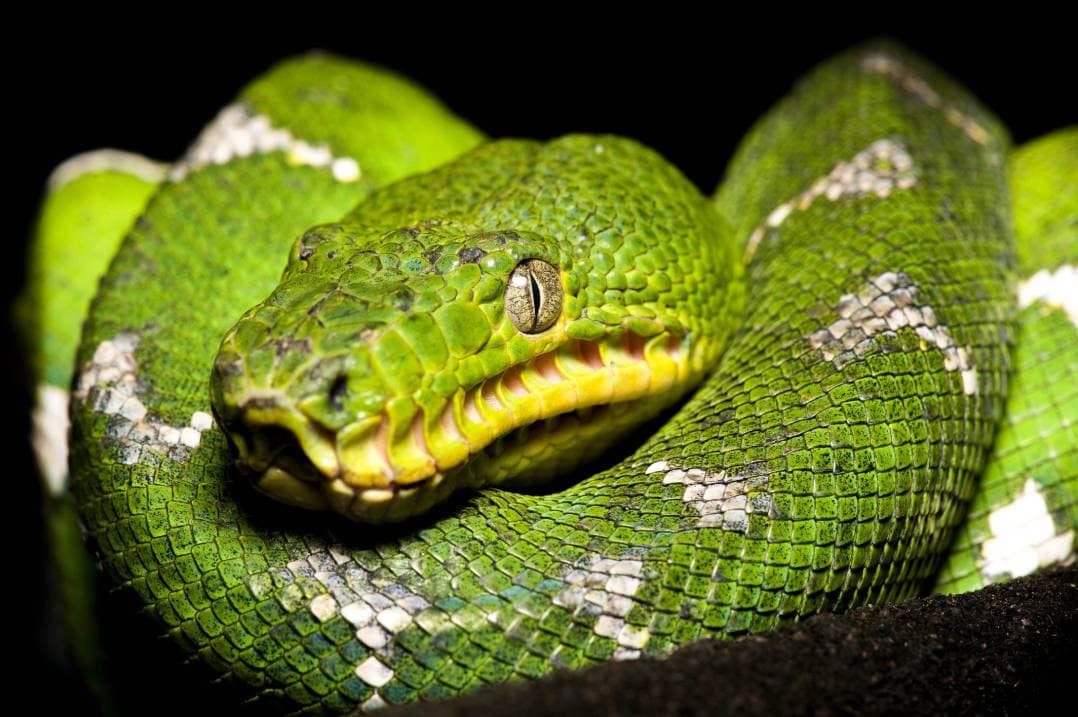
| Scientific Name: | Corallus caninus |
| Habitat: | Rainforests |
| Size: | Up to 6 feet |
The emerald tree boa is an arboreal boa that lives in the rainforests of South America. Wild emerald tree boas are known for their striking green coloration, white zigzag or “lightning bolt” stripes, and white or yellow bellies. Though non-venomous, the emerald tree boa has large front teeth that resemble viper fangs. They are one of many snakes that go through an ontogenetic color change. Neonates and juveniles are orange or red but gradually change to their adult green around nine to 12 months of age.
One of the subspecies of the emerald tree boa is the Corallus batesii, which lives in the Amazon River basin. This variation is larger and more docile than the Northern Corallus caninus, making it valuable for private collectors. Different localities have unique markings, such as a white dorsal stripe and darker or lighter colors. As a result, many emerald tree boa localities are popular in the pet trade.
3. Green Tree Python
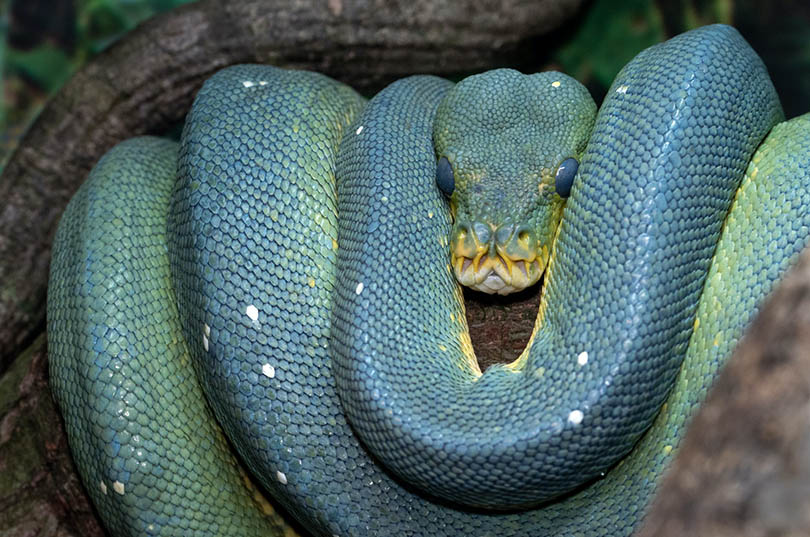
| Scientific Name: | Morelia viridis |
| Habitat: | Rainforests |
| Size: | Up to 6.6 feet |
The green tree python is an arboreal python that’s native to the rainforests of New Guinea, some parts of Indonesia, and the Cape York Peninsula in Australia. Often confused with the emerald tree boa, the green tree python is a vibrant green with a white or yellow belly and rests in a saddle position on branches. Some individuals have white, blue, or yellow dorsal markings.
Though an advanced, high-maintenance species, the green tree python is highly sought-after in the pet trade. Many illegally caught wild specimens are smuggled into the pet trade and do poorly in captivity, but captive-bred pythons thrive under the right conditions. Pythons from different localities offer variations in color, such as blue, or markings, leading to diversity in captive-breeding programs.
4. Blood Python
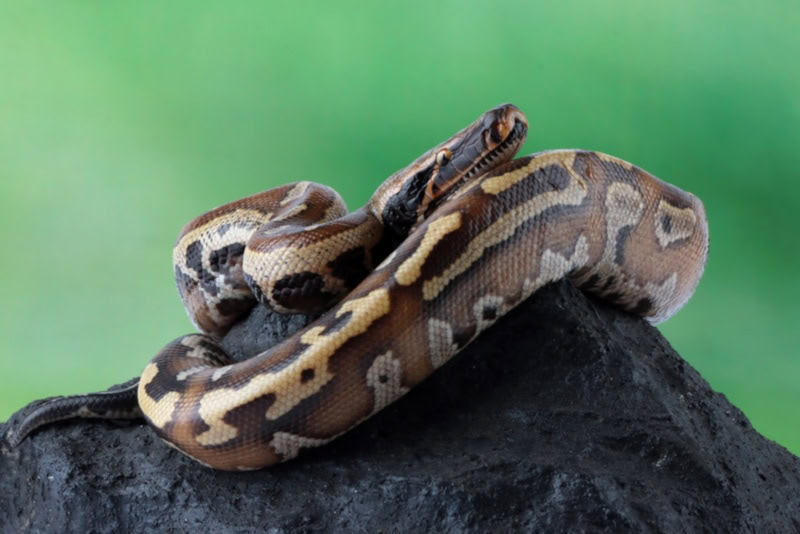
| Scientific Name: | Python brongersmai |
| Habitat: | Marshes, tropical swamps |
| Size: | Up to 6 feet |
Also known as Brongersma’s short-tailed python or the red short-tailed python, the blood python is a stout-bodied snake native to the Malay Peninsula in Sumatra. Blood pythons have rich and diverse color patterns that consist of bright red, orange, burgundy, and maroon markings, though some may have brown, yellow, or black spots or stripes. The belly is white with small black markings and the head is usually gray.
Wild blood pythons are often hunted for their skin, which is turned into leather. They are also popular in the pet trade despite an unpredictable and aggressive temperament. Wild-caught or wild-bred snakes are more aggressive and difficult to keep in captivity, but captive-bred and born snakes are hardier and more docile. As more bloodlines entered captive-breeding programs, breeders discovered new patterns and coloration that are popular among private collectors.
5. Brazilian Rainbow Boa
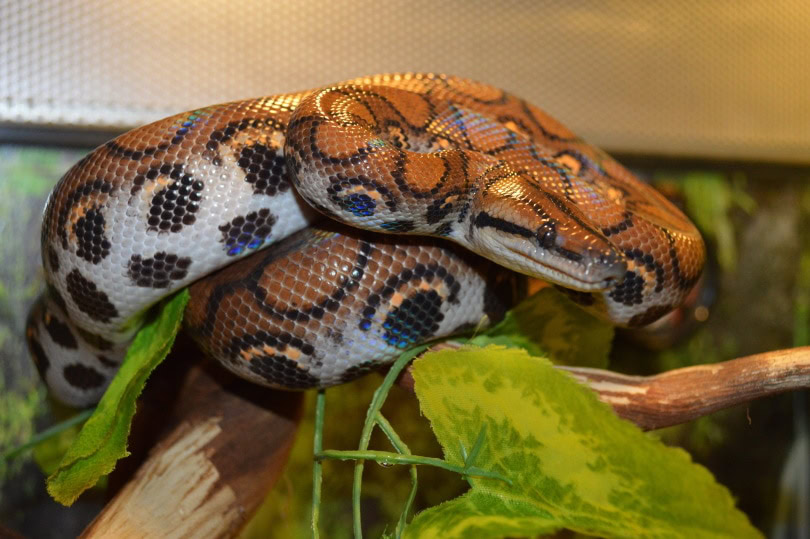
| Scientific Name: | Epicrates cenchria |
| Habitat: | Humid woodlands, rainforests |
| Size: | Up to 6 feet |
The Brazilian rainbow boa is a semi-arboreal boa native to Central and South America. The boa is named for the iridescent sheen of its scales, which creates a prism and distinctive rainbow pattern under light. Otherwise, the snake is brown or reddish-brown with black stripes and black rings on the body. Several rainbow boa subspecies are recognized, including the Espirito Santo, the Central Highland, and the Marajo Island.
Due to its beauty and manageable size, the Brazilian rainbow boa is a popular captive snake species. They require specific husbandry and don’t tolerate beginners well but thrive with intermediate-to-advanced keepers. As juveniles, Brazilian rainbow boas are nippy and shy but usually settle with regular handling.
6. Eyelash Viper
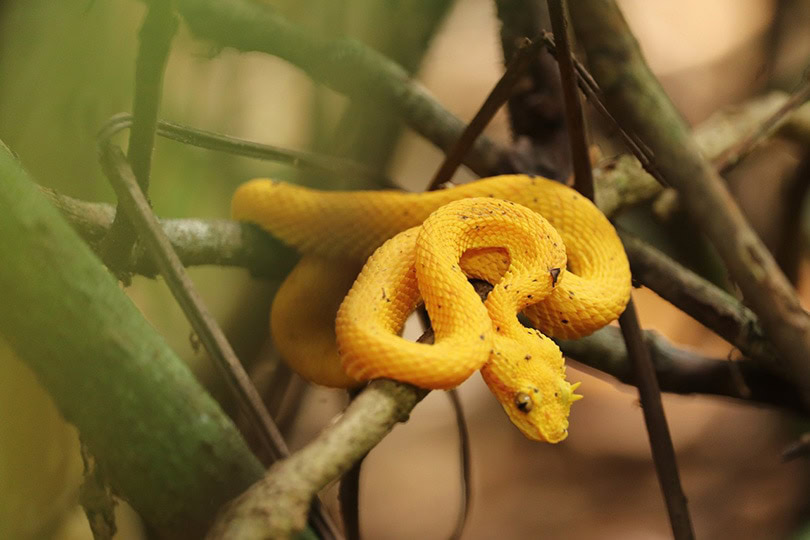
| Scientific Name: | Bothriechis schlegelii |
| Habitat: | Low-altitude, humid, tropical regions |
| Size: | Up to 27 inches |
The eyelash viper is a venomous, arboreal pit viper native to Central and South America. In addition to a range of vibrant colors, this pit viper features superciliary scales on its eyes that resemble eyelashes. These eyelashes are designed to help with camouflage. The eyelash viper occurs in diverse colors, including pink, green, brown, red, and yellow.
Despite its deadly hemotoxic and neurotoxic venom, the eyelash viper is widely available in the pet trade and commonly kept in zoos. Plenty of breeders breed captive-born snakes to create new patterns and colors, so wild-caught individuals aren’t commonly found on the market.
7. Gaboon Viper
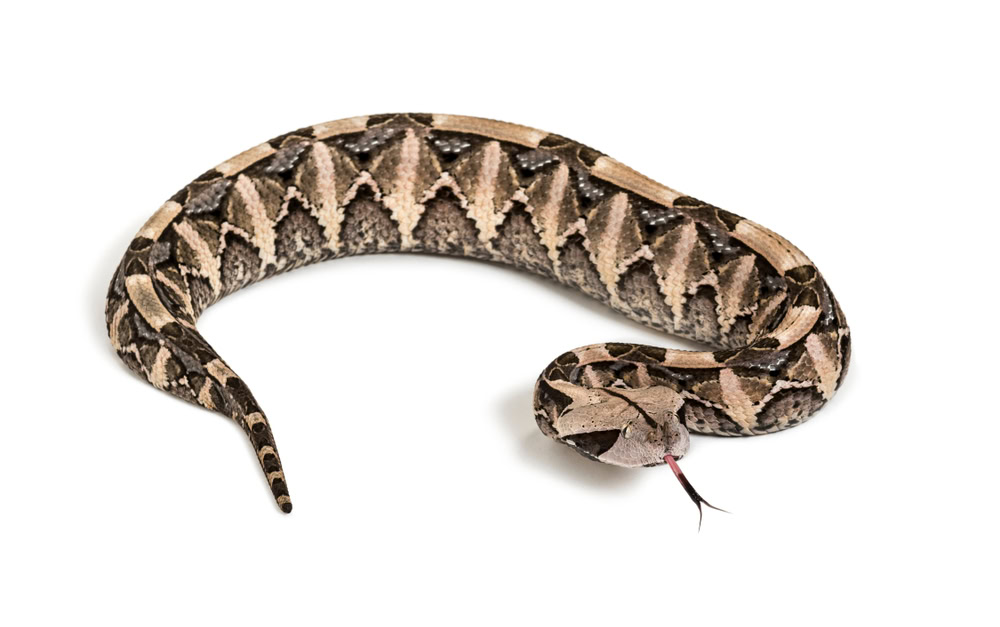
| Scientific Name: | Bitis gabonica |
| Habitat: | Sub-Saharan rainforests and savannas |
| Size: | Up to 6.7 feet |
The Gaboon viper is a stout-bodied viper native to the rainforests and savannas of sub-Saharan Africa. In addition to being the largest viper of the bitis genus, the Gaboon viper has the longest fangs of any venomous snake, measuring up to 2 inches, and the second-highest venom output of any snake. Gaboon vipers have an attractive, triangular head and a striking color pattern consisting of pale, rectangular saddles, yellow-edge hourglass markings, and brown or tan rhomboidal shapes.
Though the potent cytotoxic venom and high output pose a threat to humans, the Gaboon viper is generally docile, and attacks are rare. Due to their beauty, Gaboon vipers are commonly kept by advanced hobbyists.
8. Reticulated Python
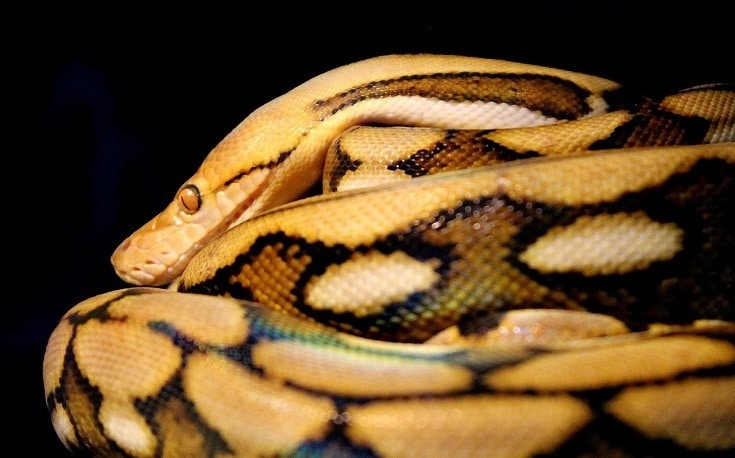
| Scientific Name: | Malayopython reticulatus |
| Habitat: | Rainforests, woodlands, grasslands |
| Size: | Up to 21 feet |
The reticulated python is the world’s longest snake. Native to South and Southeast Asia, it is highly adaptable and can swim to small islands, widening its natural range. Wild reticulated pythons feature complex geometric patterns with a range of colors and markings, lending the name “reticulate,” which means network.
Reticulated pythons are hunted for their skin and as a nuisance, but they’re still thriving in populated areas. Despite their incredible size, they are commonly found in zoological and private collections. Though some individuals can be aggressive, captive-bred and born pythons generally do well with regular handling from owners and zookeepers. Captive breeding programs yield incredible color variations in reticulated pythons, including shades of lavender, pink, peach, and white in the patterns.
9. White-Lipped Python
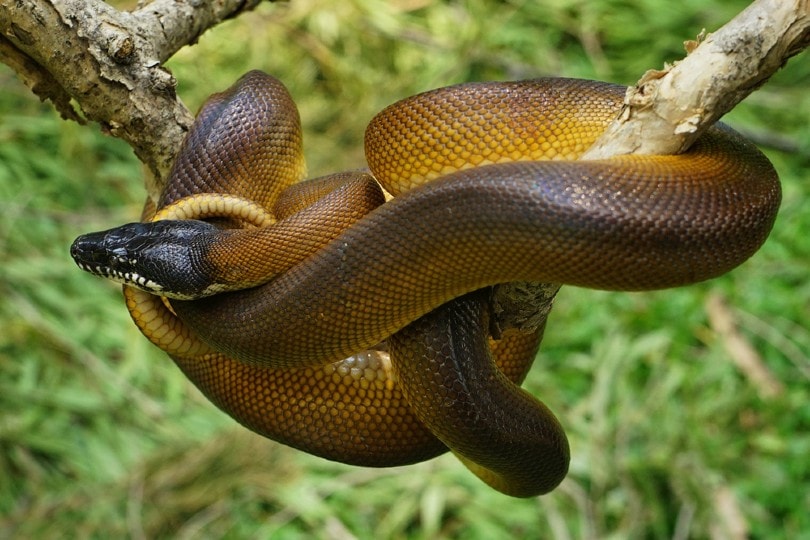
| Scientific Name: | Bothrochilus |
| Habitat: | Humid rainforests |
| Size: | Up to 7 feet |
The white-lipped python is the name for several stunning, semi-arboreal python species native to New Guinea and the surrounding islands. These include the Northern, Biak, Bismarck ringed, Karimui, Huon Peninsula, Southern, and Wau species, though the Northern and Southern species are the most common in zoos and private collections. The white-lipped python features a black or brown head with a gold- or bronze-colored body, a white belly, and white scales around the lips. Like the Boeleni’s and Brazilian rainbow boa, the white-lipped python has iridescent scales that creates a rainbow in light.
White-lipped pythons aren’t as common in captivity as other species, due in part to their poor temperament and husbandry requirements. Captive-bred and born snakes are more docile and easier to keep, though they can still be quick-tempered and nippy. This snake is ideal for experienced keepers.
10. Woma Python
| Scientific Name: | Aspidites ramsayi |
| Habitat: | Plains, prairies |
| Size: | Up to 4.5 feet |
Also known as the Ramsay’s python or the sand python, the woma python is native to Australia. It has narrow heads with small eyes and a broad, flat body with smooth scales. These snakes have a unique pattern consisting of a brown or olive-green base color with shades of red, pink, or orange and dark stripes.
In the 1960s, the woma python lost a lot of its habitat to human encroachment, but captive breeding programs in Australian zoos have restored native populations. The woma python is docile and hardy in captivity, making it a beautiful and popular option for private collectors.
11. Side-Striped Palm Pit Viper
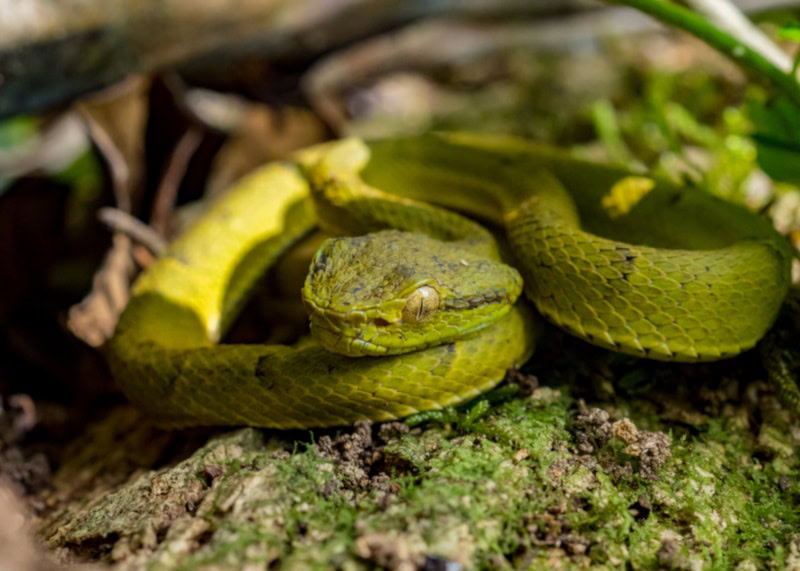
| Scientific Name: | Bothriechis lateralis |
| Habitat: | Forested, montane regions |
| Size: | Up to 3 feet |
The side-striped palm pit viper is native to the mountains of Costa Rica and western Panama. These stunning snakes have bright green or blue-green coloration with alternating vertical bar markings and a yellow belly. Some snakes have sparse scales with blue or black tips. Wild and captive side-striped palm pit vipers shift to more blue over time, though it’s more common to find blue individuals in captivity.
Though beautiful, the side-striped palm pit viper has hemotoxic venom that can kill humans. Because of this, they aren’t commonly kept in private collections.
Related Read: 20 Cute Snakes You Have to See
12. Scarlet Snake
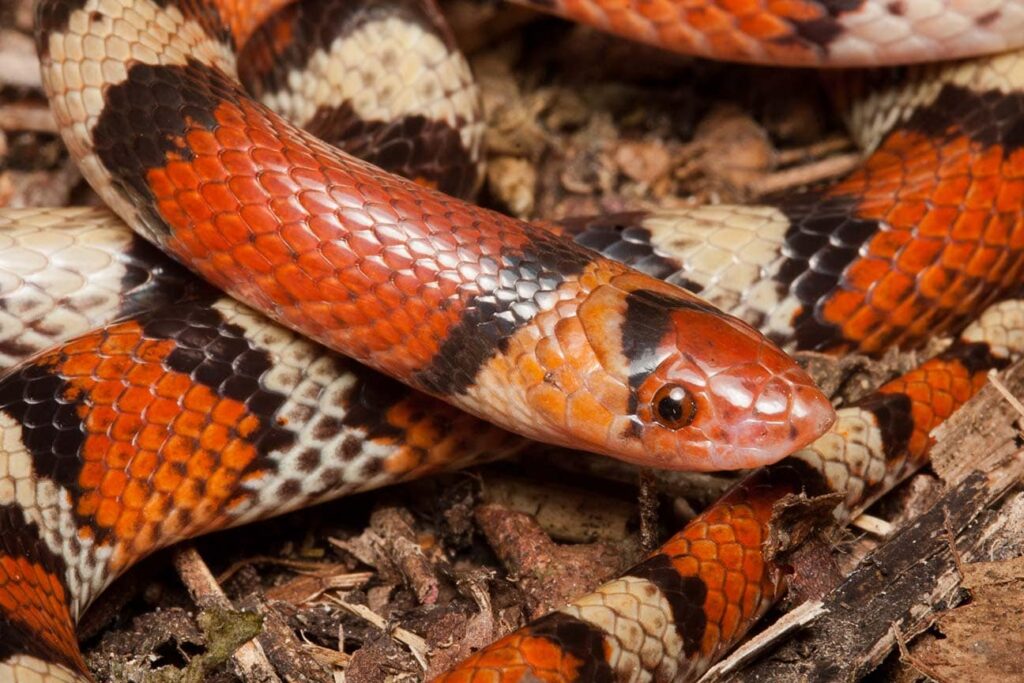
| Scientific Name: | Cemophora coccinea |
| Habitat: | Forested regions |
| Size: | Up to 2 feet |
The scarlet snake is a non-venomous colubrid native to the southeastern United States. Its striking color consists of a gray base color and black-bordered white, red, or yellow saddles that extend to the belly, giving the snake a banding or ring-like look. Scarlet snakes are mistaken for the highly venomous coral snake.
In some states, the scarlet snake is listed as an endangered or threatened species due to habitat loss, illegal capture, and direct killing. Though the snake’s docile temperament, beautiful patterns, and small size make it appealing as a pet, the scarlet snake can be a picky eater and difficult to care for. In addition, scarlet snakes are capable climbers and often escape secure enclosures.
13. San Francisco Garter Snake
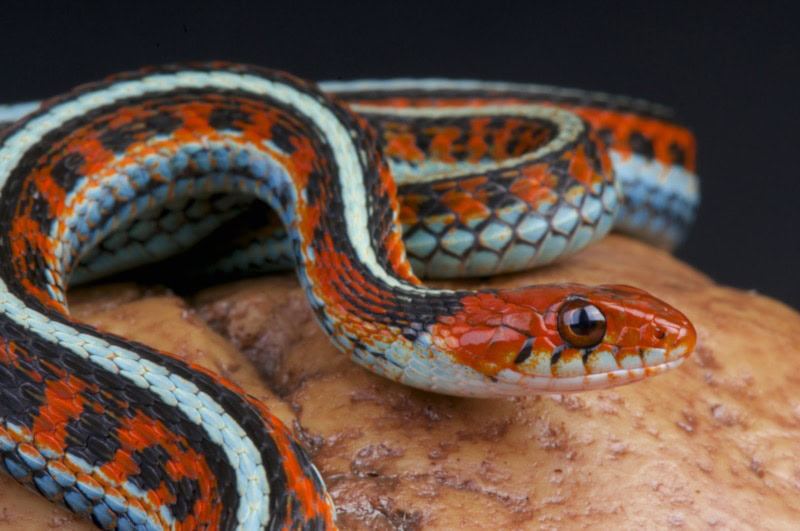
| Scientific Name: | Thamnophis sirtalis tetrataenia |
| Habitat: | Marshes |
| Size: | Up to 4.5 feet |
The San Francisco garter snake is a subspecies of the common garter snake and is native to San Mateo County and part of Santa Cruz County in California. It has a slender body and vibrant coloration with blue-green dorsal scales and black, red, orange, or blue-green stripes. Though garter snakes have mild venom in their saliva, they pose little threat to humans.
Designated as an endangered species since 1967, the San Francisco garter snake is estimated to only have a few thousand individual adults in the wild. Many factors that affected the wild population are still in effect, including habitat loss from human development and illegal capture for the pet trade. The collection of endangered species for private collections is illegal.
Conclusion
Snakes might not be the first thing that comes to mind when we think of beauty, but as we’ve seen, they come in some truly amazing colors and patterns. From the iridescent shimmer of the Boelen’s python to the bright scales of the eyelash viper, these reptiles showcase just how stunning nature can be. Whether you’re a long-time snake appreciator or just starting to become more interested in them, it’s easy to appreciate how unique and fascinating each species is. If you’re thinking about adopting a snake, make sure to research the specific species and learn about their needs and suitability as pets.
Featured Image Credit: Vaclav Sebek, Shutterstock
Contents
- The 13 Most Beautiful Snakes in the World
- 1. Boelen’s Python
- 2. Emerald Tree Boa
- 3. Green Tree Python
- 4. Blood Python
- 5. Brazilian Rainbow Boa
- 6. Eyelash Viper
- 7. Gaboon Viper
- 8. Reticulated Python
- 9. White-Lipped Python
- 10. Woma Python
- 11. Side-Striped Palm Pit Viper
- 12. Scarlet Snake
- 13. San Francisco Garter Snake
- Conclusion
